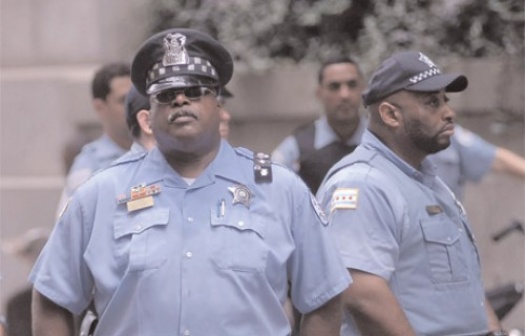
One minute a family was enjoying each other’s company behind their South Side home. The next minute they watched a relative involuntarily dance while a volley of bullets shot through his body. Shapell Terrell never had a chance, his uncle Craig Greenlaw s
“We heard a screeching sound and then heard gunshots. I called for someone to call the police. Then I looked out the window and saw that it was the police,” Greenlaw said, as he watched Terrell’s bullet-riddled body shake against the apartment building near 85th and Oglesby Avenue around 1 a.m., June 22. Greenlaw said he heard about a total of 25 gunshots; 24 too many.
“They didn’t have to kill him,” he said. “All they had to do is shoot once to get him down and then try to handle it from there if they thought he was a threat. But it didn’t take unloading his gun on the man, especially when you got him down,” Greenlaw said. Terrell, 50, had a gun and became combative; police shot him.
Two guns were recovered at the scene, according to police and a spokesman for the Independent Police Review Authority. Later that evening, Darius Nicholson was fatally shot by police during a domestic disturbance call in the 6800 block of South Aberdeen Street. Police said Nicholson was armed with a gun when they arrived to the home.
A gun was recovered at the scene. Nicholson’s family said there was no reason for the police to kill him. Families for both men refute claims by police that the men were armed. The shootings are under investigation by IPRA.
Terrell and Nicholson were the sixth and seventh people shot in the last two weeks by police. Of the nine police-involved shootings in less than two weeks, five were fatal. A 16-year-old boy was shot by police June 11 in the 13000 block of South Drexel Avenue. Three days later, a 26-year-old man was fatally shot by police in the 5800 block of South Wabash Avenue. Later the same day, an unidentified person was shot in the 5900 block of South Michigan Avenue.
On June 15, a 24-year-old man was killed by police in the 300 block of West 109th Place. The next day an unidentified man was shot by police in the 1100 block of North Pulaski Road. Of the nine shootings, one resulted in no injuries. An off-duty officer intercepted a June 11 robbery on the South Side and shot at an offender. In 2006, Chicago Police logged 44 police-involved shootings; 17 fatal. Last year there were 39 police-involved shootings; eight fatal.
Thus far this year, there were 22 police involved shootings recorded; seven fatal, according to Chicago Police spokesperson Monique Bond. Chicago Police Superintendent Jody Weis said, "The climate of violence that our youth and communities are confronted with on a daily basis underscores the need for police protection. Any loss of life is a tragedy, but police have an unparalleled responsibility to protect every community and themselves."
Ron Hampton, executive director of the National Black Police Association and a retired officer in the Metropolitan Police Department in Washington, D.C., was surprised about the numbers. But he was most surprised about the length of time between each one. “I knew there were some police-involved shootings, but wow, what is going on up there? (Police) are not going to get anywhere with that, in terms of endearing themselves with the community,” Hampton said. Hampton said it appears that the Chicago Police Department has employed military-style tactics to get a grasp on the community.
“That is destroying whatever relationship, if they ever had one, with the Black, brown and poor communities in Chicago,” he said. Earlier this year, police Superintendent Jody Weis equipped scores of officers with M4 carbine assault rifles. “(Weis) needs to get a handle on it. It seems like there’s a wave. There’s one shooting, and then the next thing you know, there are five or six in a row. Some may be justified, but some may just be an overreaction to what’s been going on,” Hampton said.
He said police may have a “superficial fear” of the community. “They shoot first, then ask questions later. What the police have in their favor is shooting first. All they have to justify is stating they were in fear of their life,” Hampton said. “There is no such thing as shoot to wound. They are trained to shoot to kill. They are trained to kill in the middle of their body. All of that trying to shoot the gun out of your hand, that’s cowboy stuff you see on TV,” he said.
In 2006, the Metropolitan Police Department had 13 police-involved shootings, two fatal. In 2007, they had 31 police-involved shootings, eight fatal, according to its 2007 Annual Report. Statistics for this year were not available at Defender presstime. Chicago’s numbers are similar to the Los Angeles Police Department’s. In 2007, there were 33 police-involved shootings, 19 fatal.
This year, from January 1-June 16, there were 21 police-involved shootings, 17 fatal, according to Officer Sara Faden, an LAPD spokesperson. James Williams, a New-Jersey based policing policies expert, was stunned by the flurry of Chicago’s police-involved shootings this month and suggested that police brass revisit excessive force training for its officers. “Whew!” Williams said.
Kathy Chaney can be reached at kchaney@chicagodefender.com
______ Copyright 2008 Chicago Defender. All rights reserved. This material may not be published, broadcast, rewritten, or redistributed.
